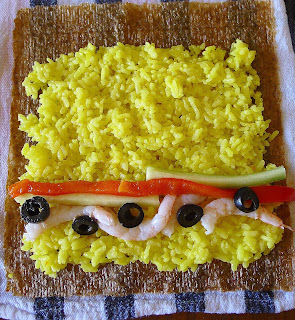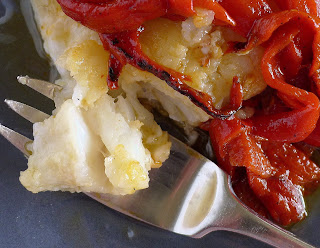 |
| Lamb burgers on split Moroccan bread with tomato-pepper salad and spicy harissa. |
Burger week began on Memorial Day with a lack of imagination—your usual ground beef from the supermercado, packaged buns, name-brand ketchup and Ben’s fantastic square-cut olive-oil fries. (National Burger Day was May 28.)
Mid-week, a cache of ground lamb in the freezer inspired me to light the grill and make Moroccan kefta. Only, I remembered that kefta, shaped like a sausage on a skewer, was never very satisfying outside the narrow lanes of the medina in Tangier. Mainly because, with my rendition, the meat tended to fall off the skewer into the fire. But, burgers would work, on the grill or on the stove.
 |
| Serve the bread in wedges or slice it open for burger buns. |
Instead of buns, I served the burgers with Moroccan bread, khobz, a round, flat loaf that is cut in wedges. Sliced open horizontally, the wedges make perfect buns for kefta or burgers. All they need is a squirt of hot harissa and Moroccan tomato-pepper salad-relish.
We’ll finish the week with fish burgers—hake cakes (like cod cakes) served on toast, slathered in garlicky green sauce.
 |
| Harissa red chile paste is a spicy accompaniment to lamb burgers. |
 |
| Salad-relish of chopped tomatoes, peppers and preserved lemons to heap on the burgers. |
 |
| Burger is served with the relish and hot harissa. |
 |
| Toast the bread or not. |
Lamb Kefta Burgers
Hamburguesas de Cordero
Hamburguesas de Cordero
Lamb cut from the leg or shoulder is best for these burgers. I like my lamb medium-rare so I shape the burgers really thick. With thick burgers and a hot grill pan, cooking takes only a few minutes. Shape them to suit yourself and adjust cooking time to your tastes.
 |
| Skewered kefta. |
If you prefer to make keftas, take a golf-ball sized piece of the burger meat and shape it around a metal skewer, pressing to make a compact sausage. Cook the skewers on a grill or under the broiler.
Makes 4-6 burgers.
 |
| Ground lamb patties with spices and cilantro. |
1 ½ pounds ground lamb
¼ cup finely chopped onion
1 clove minced garlic
2 tablespoons chopped cilantro
2 tablespoons chopped parsley
Pinch of dried mint
1 teaspoon salt
Freshly ground black pepper
1 teaspoon sweet pimentón (paprika, not smoked)
½ teaspoon smoked pimentón
1 teaspoon cumin
Olive oil for grilling the burgers
To serve:
Bread or buns
Tomato-pepper relish to accompany
Harissa chile paste to accompany
¼ cup finely chopped onion
1 clove minced garlic
2 tablespoons chopped cilantro
2 tablespoons chopped parsley
Pinch of dried mint
1 teaspoon salt
Freshly ground black pepper
1 teaspoon sweet pimentón (paprika, not smoked)
½ teaspoon smoked pimentón
1 teaspoon cumin
Olive oil for grilling the burgers
To serve:
Bread or buns
Tomato-pepper relish to accompany
Harissa chile paste to accompany
Place the lamb in a bowl. Add all the remaining ingredients except the oil. Use a fork to lightly mix the meat. Allow to stand at room temperature for 30 minutes.
Shape meat into burgers of desired size and thickness.
Prepare grill, if using, or heat a plancha grill pan or heavy cast iron skillet. Drizzle or brush the burgers with oil. Cook them, turning once, to desired doneness, 2-4 minutes, depending on thickness.
Serve the burgers on quartered Moroccan bread, split horizontally, or on burger buns. Accompany with tomato-pepper relish and harissa chile paste.
 |
| Burger bun is a quarter of round loaf, split horizontally. |
Tomato-Pepper Relish
Ensaladilla de Tomates y Pimiento
Ensaladilla de Tomates y Pimiento
 |
| Preserved lemon. |
Brine-cured Moroccan preserved lemon adds a special tang to this relish. Use the chopped rind, with or without the flesh and membrane. If preserved lemon is not available, use chopped green olives plus grated lemon zest.
The salad can be prepared in advance and refrigerated, covered, until ready to serve. The salt draws the liquid out of tomatoes and cucumbers. Use a slotted spoon to serve the salad. (Use more bread to mop up the juices remaining.)
Add hot harissa to the salad or serve it on the side for everyone to add to taste.
 |
| Add caption |
Makes enough for 4-6 burgers.
1 cup finely chopped tomatoes
¼ cup finely chopped spring onions
¼ cup finely chopped green pepper
¼ cup finely diced cucumber (optional)
2 tablespoons chopped cilantro
2 tablespoons chopped preserved lemon
1 tablespoon extra virgin olive oil
½ teaspoon salt
2 teaspoons fresh lemon juice
Harissa chile paste (optional)
¼ cup finely chopped spring onions
¼ cup finely chopped green pepper
¼ cup finely diced cucumber (optional)
2 tablespoons chopped cilantro
2 tablespoons chopped preserved lemon
1 tablespoon extra virgin olive oil
½ teaspoon salt
2 teaspoons fresh lemon juice
Harissa chile paste (optional)
Combine the tomatoes, onions, green pepper and cucumber, if using, in a bowl. Add the cilantro, preserved lemon, oil, salt, lemon juice and harissa, if using. Toss lightly.
Relish can be made in advance and refrigerated, covered, for several hours. Use a slotted spoon to spoon it onto burgers.
Harissa Chile Paste
Salsa Picante
Salsa Picante
Moroccan “ketchup.” This spicy- hot condiment is available in jars and squeeze tubes from specialty food shops. It’s made with ground chilies. However Spanish “hot” pimentón picante (paprika, not smoked), makes a perfect substitute for grinding peppers. It is way spicier than ordinary sweet pimentón/paprika but not as hot as cayenne. It’s usually served in small pots with any Moroccan meal.
1 tablespoon hot pimentón (paprika, not smoked)
2 tablespoons boiling water
1/8 teaspoon salt
1 teaspoon olive oil
2 tablespoons boiling water
1/8 teaspoon salt
1 teaspoon olive oil
Place the pimentón in a small, heat-proof bowl. Stir in the boiling water until smooth. Stir in the salt and oil. Store, refrigerated, for up to a week.
Moroccan Bread (Khobz)
Pan Marroquí
 |
| Not a flatbread, but a flattened loaf with a springy crumb. |
This flattened round loaf, cut into wedges, is served with every Moroccan meal. It is traditional with all kinds of tagine.
I’ve used fresh yeast because that’s what I’ve got. You can substitute 1 envelope active dry yeast.
Makes 2 (9-inch) round loaves.
1 ounce pressed fresh yeast
1 teaspoon sugar
1 ¼ hand-hot water (1l0ºF)
3 cups bread flour + additional for the board
1 cup whole wheat flour
1 teaspoon sugar
1 ¼ hand-hot water (1l0ºF)
3 cups bread flour + additional for the board
1 cup whole wheat flour
2 teaspoons salt
2 tablespoons olive oil + additional for oiling bowl and pan
Semolina for baking sheet
¼ teaspoon aniseed (optional)
2 teaspoons sesame seed (optional)
2 tablespoons olive oil + additional for oiling bowl and pan
Semolina for baking sheet
¼ teaspoon aniseed (optional)
2 teaspoons sesame seed (optional)
Crumble the pressed yeast into a small bowl. Add the sugar and ¼ cup of warm water. Stir to dissolve the yeast and allow it to stand for 5 minutes until bubbly.
Place the two kinds of flour in a large bowl. Stir in the salt. Make a well in the center. Pour in the yeast, the remaining warm water and olive oil. Use a wooden spoon to gradually mix the flour into the wet ingredients.
Once the dough comes together in a mass, turn out onto a lightly floured board. Knead the dough 5-10 minutes until smooth and stretchy. Add only enough flour to keep the dough from sticking. It will become less sticky with kneading. Gather the dough into a ball. Invert the mixing bowl on top of the dough and leave it on the board for 15 minutes (or up to 1 hour).
Knead the dough again until smooth. Knead in the aniseed, if using. Lightly oil the mixing bowl. Divide the dough into two equal-sized balls. Roll them in the oiled bowl.
 |
| Press the ball of dough to flatten it. |
Prepare a rimmed baking sheet by oiling it lightly and sprinkling with semolina. Place the balls of dough on the sheet. Pat them into rounds approximately 2 inches thick. If using sesame, sprinkle it on the tops and press it into the dough.
Cover the dough with a clean dry cloth and leave in a warm place to rise for 2 hours.
Heat oven to 400ºF.
 |
| After rising, prick the dough with a fork before baking. |
Prick the rounds of dough with a fork. Bake until the breads are golden and sound hollow when tapped on the bottom, about 40 minutes.
Cool the bread on racks. Serve it, cut into wedges, in a cloth-covered bread basket with any Moroccan-style meal.
References for Moroccan food:
Moroccan Cuisine by Paula Wolfert (Grub Street; 2004)
The Scent of Orange Blossoms—Sephardic Cuisine from Morocco by Kitty Morse and Danielle Mamane (Ten Speed Press; 2001).
Moroccan Cuisine by Paula Wolfert (Grub Street; 2004)
The Scent of Orange Blossoms—Sephardic Cuisine from Morocco by Kitty Morse and Danielle Mamane (Ten Speed Press; 2001).
Taste of Maroc by Christine Benlafquih.
More burgers:
More buns:
More recipes to serve with Moroccan bread:


















































